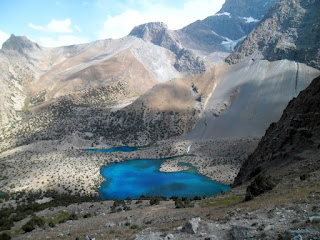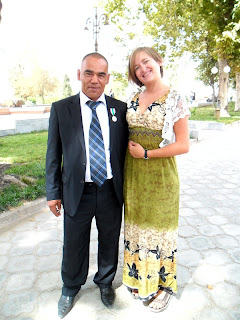What do you guys know about Tajikistan?
What?!
Hm...
yes, the capital is Dushanbe. Correct! You were quite fast in checking this on wikipedia ;)
I do admit that me too I didn't know anything, literally ANYTHING about Tajikistan before showing more interest in the region all together. And when deciding what I want to see and do in Tajikistan, I was following the same ideas like everybody: doing the famous Pamir Highway. Many people we met in Central Asia were travelling by bike and the Pamir Highway is a really famous road for bikers. But even in a car it is well worth doing it. That's what I think, because in the end I didn’t go there (all photos of mountains here are from the Fan Mountains, not the Pamirs)...
When I applied for my visa to Tajikistan in Almaty in the end of July, I also wanted a GBAO-permit. GBOA stands for "Gorno Badakshan Automous Oblast", which is the region the Pamirs are actually in. But just one or two days before my application, a powerful former KGB-officer had been stabbed to death in regions capital Khorog. The incident lead to heavy military presence in the region (against the opposition strongman Tolib Ayombekov, who was suspected to be involved), the total blockage of the region and turmults with many deaths – and a closure of the region to tourists, which is still effective as I am writing this story right now. So: sorry, no GBAO-permit.
You can imagine that such an incident has a long history before happening, and I am trying my best now to recite a bit about Tajikistans history – not only because it in the end affected my travels, but also because I think that Tajikistan is a great country and it is worth knowing more about it.*
Tajikistan had always been the poorest of all Sovereign Soviet Republics; and it was the Union who managed “to hold the lit on the pressure-cooker of the clan-based tensions that had long existed before the Russian invention.” (LP Central Asia 2010: 376) But once the Soviet Union fell apart and the different states declared independence – Tajikistan on the 9th Septeber 1991 – the whole thing blew off: uprisings, elections, opposition in exile and finally a civil war, which destroyed even more of the already poor country and its economy. The civil war ended with a peace agreement in 1997. The first president of the republic Emomalii Rahmon, elected in 1992, is still in power today and is most probably winning the elections again next year – making him president for four instead of two allowed terms (the courts had decided that the first two terms didn’t count).
Apart from this road we didn’t see many sealed roads at all. All the roads into the valleys are dusty, bumpy, unsealed roads which are not easy to drive on unless you have a 4WD.
So yes, Tajikistan is still a really poor country, and this comment proves it: “the annual national budget of Tajikistan remains less than the budget of a major Hollywood move, and 40% of that is required for the upkeep of the military presence on the Afghan border.” (Lonely Planet 2010: 378) Many Tajiks are therefore working in Russia (mainly in construction) and are sending a lot of money back home. So the remittances make up a large part of the national income. We met quite some people whose sons were working in Moscow (leaving wives and children with the parents) or had been working in Moscow by themselves to earn more money.
But still: a big part of the national income is sadly related to the drug traffic: “50% of Tajikistan’s economic activity is thought to be somehow linked to the drug trade.” (Lonely Planet 2010: 378) – And here I am coming to the end of my short historic and economical introduction, leading me back to the starting point: the incident in Khorog, which was the reason for to the closure of the Pamirs:
A French girl we met in Dushanbe, who is writing her thesis in anthropology about Tajik women, told us what she had heard about the incidet (so all this here is rumours after all): after the civil war the guerrilla fighter from the Pamirs had been integrated into the system and the former leaders got higher positions in the police, military or administration (however, never gave back their arms)– like it was also the case for this former KGB. He had somehow been involved with the smuggling of a whole truck full of cigarettes from Afghanistan, which had been stopped and seized by the police around Khuyab (the region of the actual president). Of course this led to problems, because the cigarettes hadn’t been delivered and the providers still wanted money and in all this turmoil the guy got killed. The result for the people in the Pamirs was terrible though: without many of them knowing anything about it, the region had been literally shut from the rest of the country overnight a few days after the incident: they cut any existing internet connection, the mobile reception and the roads and sent heavy military into the region. Many people died during the invention.
Long story, just to tell you that finally I couldn’t make it to the Pamirs... But Tajikistan is more than just the Pamirs, and we were really happy with what we managed to see in the few days we stayed in the country. Tajikistan is so much more than just the Pamirs, and when looking at the map right now, I really wonder why other travellers sometimes say “Tajikistan is closed” (as equivalent to “The Pamirs are closed”, when we told them that we were heading there, as if there was nothing else to do in Tajikistan.
We concentrated our short stay onto two things: Dushanbe (guess why… Wow!! You got it! Visa applications) and while waiting for the visa we went into the Zerafshan valley, a region which is – at least among tourists –well known for its treks. Through a guesthouse of the valleys capital Penjikent we had organized everything we needed: a tent, one more sleeping-bag, mats, a donkey, who would carry our load and a donkey-man, who would accompany and guide us and take care of the donkey. At the local bazaar we bought tons of food (knowing we wouldn’t have to carry it by ourselves) and then finally took the bus to the small village, from where the trek would start and where our donkey-man awaited us already – with vodka.
The trek through the Fan mountains and past beautiful aquamarine blue and turquoise lakes was just amazing. A Swiss couple we had met a week before had told us that the Fan mountains were only “Geröll” (rubble). Man, guys!! Open your eyes!! Yes, the mountains are really stony and there are not many trees around – but still, the nature is breathtaking!
Every evening our nice guide would cook for us and while waiting for the food to be ready, we would start drinking vodka with zakuskis. Well, vodka in post-USSR is a big thing: and if you don’t want more than one shot, well, rather stick with none at all: once you started drinking with people, you’re will never ever be allowed to stop anymore…
In Marguzor we immediately were guided to the local homestay, which is part of the ZTDA-network, a community-based tourism network build with the help of Germans. Like it was the case with the CBT in Kyrgyzstan, I had written about in my last story, the ZTDA has an open price policy and provides a lot of services apart from homestays and aims for a win-win-situation for both the tourists and the local communities.
Staying in this tiny village we saw a lot about the everyday life of people on the countryside or in the mountains. Everybody in the village was involved in the harvest and therefore really busy: we saw many people working on the fields, girls picking fruits, and kids bringing donkeys to where they were needed. In the village itself huge piles of grains were on the floor and donkeys would be walking on them to get the grains out (at least, that’s what we think they are doing. We bloody city-people don’t have any idea about absolutely basic farming anymore…)
Whereas in Dushanbe people would dress rather modern and fashionable, in the mountains people all dress the same: the women have colourful dresses covering their figures and headscarves and the men have trousers and shirts and the typical Tajik hat.
In the various shared taxis from and to and again from and to Dushanbe we had the chance to talk with many people of course. It is amazing that some questions stay the same all over the whole region: “Вы откуда? Вы замужем? Дети есть? Сколько у Вас лет?“ „Where are you from? Are you married? Do you have children? How old are you?” – when answering no to both – the married and kids – questions you’ll get a really perplexed look or the answer, that with your age nobody would take you anymore… nice, thank you!
But every country has its particular questions too. In Tajikistan it is a lot about money: how many times where we asked how much it would cost to travel to Europe. Or how much the average pay in our country is (we don’t really like these questions and when answering them usually point out that life is much more expensive back home, because we really don’t want them to believe that Europe is all super-easy and everybody back home is rich).
And after a few phrases they want you to invite them to Europe…
One of the men (of course always men...) who would ask us a lot about our lives back home, was the cotton grower Abdullak. We met him first on our initial ride from the North to Dushanbe, where he went to because he was about to receive a medal of honour from the president: he had founded a cotton company in the North, with which he created loads of work in the region. Somehow this remembered me of the medals for the best worker in the USSR... And according to him he is now the biggest cotton grower in the whole Khojand region. We met him again the next day by chance when walking down the main ally of Dushanbe, when he already had a nice medal pinned to his suit.
And again I can only underline that people in Central Asia are really, really inviting and guest friendly: he not only invited us to have lunch with him in Dushanbe, but also invited us to his home in Khojand (the country’s second largest city in the North, next to Uzbekistan). We couldn’t make it to his home, because we only realised then that he in fact lived far away from Khojand itself. So when we passed Khojand again he came all the way from his home to pick us up and have dinner with us...
Oh yes, dear men of Central Asia - my next story will be entirely about you...
Like always: check out the great photos of Tajikistan in my gallery, and I also updated the money-page.
*At the time of writing I was sitting in a train and was hence mostly using the Lonely Planet as source of information in lack of internet connection and other sources.








































